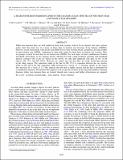| dc.contributor.author | Cackett, E. M. | |
| dc.contributor.author | Miller, J. M. | |
| dc.contributor.author | van der Klis, M. | |
| dc.contributor.author | Méndez, M. | |
| dc.contributor.author | Raymond, J. | |
| dc.contributor.author | Steeghs, D. | |
| dc.contributor.author | Wijnands, R. | |
| dc.contributor.author | Homan, Jeroen | |
| dc.contributor.author | Lewin, Walter H. G. | |
| dc.date.accessioned | 2015-03-16T15:27:11Z | |
| dc.date.available | 2015-03-16T15:27:11Z | |
| dc.date.issued | 2008-12 | |
| dc.date.submitted | 2008-01 | |
| dc.identifier.issn | 0004-637X | |
| dc.identifier.issn | 1538-4357 | |
| dc.identifier.uri | http://hdl.handle.net/1721.1/96033 | |
| dc.description.abstract | While iron emission lines are well studied in black hole systems, both in X-ray binaries and active galactic nuclei, there has been less of a focus on these lines in neutron star low-mass X-ray binaries (LMXBs). However, recent observations with Suzaku and XMM-Newton have revealed broad, asymmetric iron line profiles in three neutron star LMXBs, confirming an inner disk origin for these lines in neutron star systems. Here, we present a search for iron lines in six neutron star LMXBs. For each object we have simultaneous Chandra and RXTE observations at two separate epochs, allowing for both a high-resolution spectrum and broadband spectral coverage. Out of the six objects in the survey, we only find significant iron lines in two of the objects, GX 17+2 and GX 349+2. However, we cannot rule out that there are weak, broad lines present in the other sources. The equivalent width of the line in GX 17+2 is consistent between the two epochs, while in GX 349+2 the line equivalent width increases by a factor of ~3 between epochs as the source flux decreases by a factor of 1.3. This suggests that the disk is highly ionized, and the line is dominated by recombination emission. We find that there appears to be no specific locations in the long-term hardness–intensity diagrams where iron emission lines are formed, though more sources and further observations are required. | en_US |
| dc.language.iso | en_US | |
| dc.publisher | IOP Publishing | en_US |
| dc.relation.isversionof | http://dx.doi.org/10.1088/0004-637x/690/2/1847 | en_US |
| dc.rights | Article is made available in accordance with the publisher's policy and may be subject to US copyright law. Please refer to the publisher's site for terms of use. | en_US |
| dc.source | American Astronomical Society | en_US |
| dc.title | A SEARCH FOR IRON EMISSION LINES IN THE CHANDRA X-RAY SPECTRA OF NEUTRON STAR LOW-MASS X-RAY BINARIES | en_US |
| dc.type | Article | en_US |
| dc.identifier.citation | Cackett, E. M., J. M. Miller, J. Homan, M. van der Klis, W. H. G. Lewin, M. Méndez, J. Raymond, D. Steeghs, and R. Wijnands. “ A SEARCH FOR IRON EMISSION LINES IN THE CHANDRA X-RAY SPECTRA OF NEUTRON STAR LOW-MASS X-RAY BINARIES .” The Astrophysical Journal 690, no. 2 (December 30, 2008): 1847–1855. © 2009 The American Astronomical Society. | en_US |
| dc.contributor.department | Massachusetts Institute of Technology. Department of Physics | en_US |
| dc.contributor.department | MIT Kavli Institute for Astrophysics and Space Research | en_US |
| dc.contributor.mitauthor | Homan, Jeroen | en_US |
| dc.contributor.mitauthor | Lewin, Walter H. G. | en_US |
| dc.relation.journal | Astrophysical Journal | en_US |
| dc.eprint.version | Final published version | en_US |
| dc.type.uri | http://purl.org/eprint/type/JournalArticle | en_US |
| eprint.status | http://purl.org/eprint/status/PeerReviewed | en_US |
| dspace.orderedauthors | Cackett, E. M.; Miller, J. M.; Homan, J.; van der Klis, M.; Lewin, W. H. G.; Méndez, M.; Raymond, J.; Steeghs, D.; Wijnands, R. | en_US |
| mit.license | PUBLISHER_POLICY | en_US |
| mit.metadata.status | Complete | |
